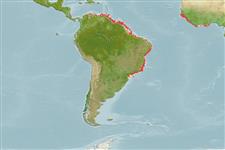Common names from other countries
Environment: milieu / climate zone / depth range / distribution range
Écologie
; profondeur 0 - 30 m (Ref. 83435). Tropical; 12°N - 28°S, 62°E - 0°E (Ref. 83435)
Distribution
Pays | Zones FAO | Écosystèmes | Occurrences | Introductions
Atlantic Ocean: Trinidad and Tobago to Brazil, and tropical West Africa.
Length at first maturity / Taille / Poids / Âge
Maturity: Lm ? range ? - ? cm Max length : 16.6 cm DL mâle / non sexé; (Ref. 83435); common length : 16.0 cm TL mâle / non sexé; (Ref. 355)
Description synthétique
Morphologie
Shell fusiform, spire high, anterior canal well developed, shell surface with sculpture of many fine spiral threads. Shoulder angular, with single row or nodules. Periostracum thick and hairy. Colour: chocolate brown to black, with a few contrasting white bands, periostracum brownish.
Lives on mud and other soft substrates in mangrove areas and near river estuaries. Feeds mainly on carrion (Ref. 355).
Life cycle and mating behavior
Maturité | Reproduction | Frai | Œufs | Fécondité | Larves
This species is a non-broadcast spawner. Life cycle does not include trocophore stage. Also Ref. 833.
Leal, J.H. 2003. (Ref. 355)
Statut dans la liste rouge de l'IUCN (Ref. 130435)
statut CITES (Ref. 108899)
Not Evaluated
Not Evaluated
Menace pour l'homme
Harmless
Utilisations par l'homme
| FishSource |
Outils
Plus d'informations
Taille/ÂgeCroissanceLongueur-poidsLongueur-longueurMorphologieLarvesAbondance
Sources Internet
Estimates based on models
Preferred temperature
(Ref.
115969): 26.7 - 28.3, mean 27.5 (based on 255 cells).
Catégorie de prix
Unknown.
